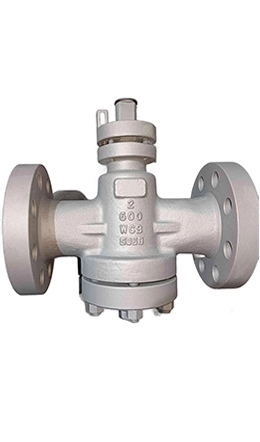Selecting the right valve is crucial for ensuring system efficiency, safety, and longevity in industrial, commercial, and residential applications. Globe valves and plug valves are two widely used valve types, each excelling in specific functions. Globe valves are ideal for precise flow regulation, while plug valves are designed for quick on/off control. At KFTE Valves, we offer high-quality globe valves and plug valves tailored for diverse industries. This guide compares their designs, advantages, disadvantages, and applications to help you choose the best valve for your needs.
A Globe Valve is a linear-motion valve designed for precise flow regulation and throttling. It features a spherical body with an internal baffle that directs flow through a movable plug, controlled by a stem. The plug adjusts the flow by moving up or down, allowing fine-tuned control. Globe valves are commonly used in high-pressure systems requiring accurate flow modulation, such as in oil and gas, chemical processing, and HVAC. For example, a Cast Globe Valve is ideal for steam control in power plants.

A Plug Valve is a quarter-turn valve used for on/off flow control. It features a cylindrical or conical plug that rotates within the valve body to open or close the flow passage. Plug valves provide tight shutoff, making them suitable for applications requiring minimal leakage, such as in chemical processing, water treatment, and oil and gas. Their simple design ensures reliable operation with low viscosity fluids, slurries, and abrasive media. A Plug Valve is often used in pipelines for quick isolation.

Globe and plug valves differ in functionality, design, and application. Below are the primary distinctions:
Globe valves excel at throttling and precise flow control, allowing operators to adjust flow rates accurately. Plug valves are designed for on/off control, providing full flow or complete shutoff with minimal throttling capability. For instance, a Forged Globe Valve is used for chemical dosing, while a Plug Valve isolates flow in gas pipelines.
Globe valves have a complex design with a spherical body, baffle, plug, and stem, resulting in more components and potential leak points. Plug valves have a simpler design with a rotating plug, fewer parts, and lower risk of leakage, enhancing durability in abrasive applications.
Globe valves cause a higher pressure drop due to their tortuous flow path, which can reduce system efficiency. Plug valves offer minimal pressure drop with a straight-through flow path, making them ideal for high-flow systems.
Globe valves require more maintenance due to their complex structure and susceptibility to wear in the orifice. Plug valves need less maintenance, but their plugs may wear in abrasive or high-temperature conditions, requiring periodic inspection.
Globe valves are generally more expensive due to their intricate design and materials. Plug valves are more cost-effective, offering simplicity and lower production costs, though high-performance models can be pricier.
| Feature | Globe Valve | Plug Valve |
|---|---|---|
| Function | Throttling and flow control | On/off control |
| Pressure Drop | High | Minimal |
| Design | Complex, more components | Simple, fewer components |
| Maintenance | Higher, due to wear | Lower, durable design |
| Cost | Higher | Lower |
| Applications | Oil and gas, HVAC, chemical | Water treatment, slurries, gas |
Globe Valves are suited for applications requiring precise flow control, including:
Oil and Gas: Regulating flow in high-pressure pipelines.
Chemical Processing: Controlling chemical injection for accurate dosing.
HVAC Systems: Modulating coolant or steam flow for temperature control.
Pharmaceuticals: Managing precise fluid flow in sterile processes.
Plug Valves are ideal for on/off control in various systems, such as:
Water Treatment: Isolating flow in treatment plants.
Chemical Processing: Handling slurries or abrasive media.
Oil and Gas: Providing tight shutoff in gas distribution lines.
Pulp and Paper: Managing viscous fluids in processing lines.
Selecting the appropriate valve depends on your system's specific requirements. Consider these factors:
Flow Control Needs: Choose a globe valve for precise throttling; select a plug valve for quick on/off control.
Fluid Properties: Globe valves handle high-viscosity fluids well; plug valves are better for low-viscosity fluids, slurries, or abrasive media.
Pressure and Temperature: Globe valves are ideal for high-pressure systems; plug valves suit high-pressure but may wear in extreme temperatures.
Maintenance Requirements: Plug valves require less maintenance; globe valves need regular upkeep due to their complex design.
Budget: Plug valves are more cost-effective for simple applications; globe valves are a premium choice for precision control.
For demanding applications, a Forged Globe Valve offers enhanced durability, while a Plug Valve provides reliable shutoff in harsh environments.
Globe Valves:
Advantages: Precise throttling, versatile for various fluids, reliable in high-pressure systems, customizable designs.
Limitations: High pressure drop, limited high-flow capacity, higher cost, more maintenance required.
Plug Valves:
Advantages: Tight shutoff, simple design, low maintenance, handles slurries and abrasive media, cost-effective.
Limitations: Limited throttling, high operating torque, wear in abrasive conditions, less suited for high-viscosity fluids.
At KFTE Valves, we provide premium Cast Globe Valves, Forged Globe Valves, and Plug Valves engineered for reliability and efficiency. Our valves are crafted with high-quality materials to meet the demands of industries like oil and gas, chemical processing, and water treatment. Explore our catalogs at Globe Valves and Plug Valves or contact our team at KFTE Valves for expert guidance on your flow control solutions.
Wikipedia. (2025). Globe Valve. An overview of globe valve design and applications. Available at: https://en.wikipedia.org/wiki/Globe_valve.
Wikipedia. (2025). Plug Valve. An overview of plug valve functions and uses. Available at: https://en.wikipedia.org/wiki/Plug_valve.
This is the first one.